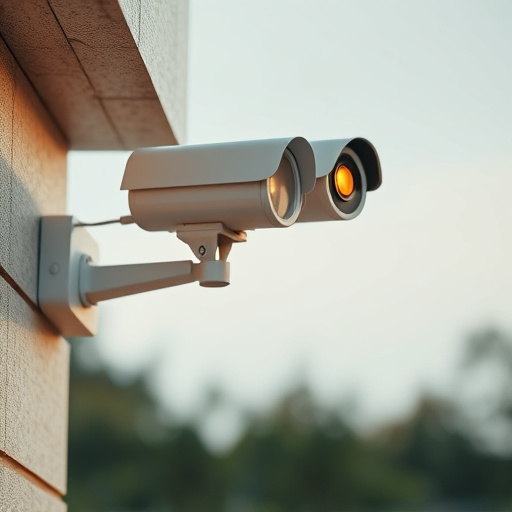Mounting dummy security cameras under eaves offers a strategic, discreet home security solution with multiple benefits. These wire-free cameras, powered by batteries or rechargeable sources, provide easy installation and maintenance while staying hidden from view. By selecting weatherproof models with optimal range and vision angle, homeowners ensure comprehensive coverage without blind spots, enhancing overall protection and peace of mind. Proper installation techniques, regular lens cleaning, and power connection checks are essential for maximizing the effectiveness of these cameras in both security and aesthetic applications.
In the realm of home security, dummy security cameras offer a cost-effective solution without the need for constant surveillance. When integrating these devices, understanding their power requirements is key. This article explores the intricacies of mounting dummy cameras under eaves, a strategy that enhances both aesthetics and functionality. We delve into various power options, providing a detailed look at how to best utilize and maintain these security enhancements, specifically focusing on the benefits of Mounting Dummy Cameras Under Eaves.
- Understanding Dummy Security Camera Requirements
- Benefits of Mounting Under Eaves
- Power Options for Dummy Cameras: A Detailed Look
- Best Practices for Installation and Maintenance
Understanding Dummy Security Camera Requirements
When it comes to mounting dummy security cameras, especially under eaves, understanding your camera’s power requirements is paramount. Unlike their real counterparts that rely on direct connection to a power source or Wi-Fi, dummy cameras often operate on battery power or are designed for plug-and-play convenience with rechargeable batteries. This flexibility makes them ideal for discrete placement and easy installation without the need for complex wiring.
Mounting under eaves offers several advantages: it keeps the camera out of plain sight while still providing a clear line of sight; and it allows for discreet power connections, ensuring your security system remains unnoticeable yet functional. Whether you opt for battery-powered models or those with rechargeable batteries, selecting cameras designed for outdoor use is crucial to withstand varying weather conditions. Additionally, consider the camera’s range and vision angle to ensure optimal coverage without any blind spots.
Benefits of Mounting Under Eaves
Mounting dummy cameras under eaves offers a discreet and effective solution for home security. By positioning the cameras in this strategic location, homeowners can capture clear footage of their property without drawing unnecessary attention. The eaves provide natural cover, ensuring the cameras blend seamlessly into the environment, making them less noticeable to potential intruders. This subtle approach enhances the overall aesthetic appeal while maintaining a high level of surveillance.
Additionally, mounting under the eaves allows for optimal viewing angles and improved visibility. The elevated position offers a broader field of view, enabling better monitoring of entry points, such as doors and windows, as well as the surrounding area. This enhanced line of sight means homeowners can quickly identify any suspicious activity or potential security breaches, providing peace of mind and an added layer of protection for their homes and families.
Power Options for Dummy Cameras: A Detailed Look
Powering your dummy security cameras is a crucial step in ensuring they function effectively and discreetly. One popular and convenient option is to mount them under eaves. This strategic placement offers several advantages, including protection from the elements and easy access for battery changes or charging. By mounting under an eave, you can conceal the camera’s power source while still maintaining reliable electricity supply.
This method is particularly ideal for dummy cameras designed with a wire-free setup, as it eliminates the need for unsightly cables hanging from the roof. It also allows for discreet installation, enhancing the visual appeal of your security system. Moreover, many modern dummy cameras come equipped with rechargeable batteries or solar panels, making them even more versatile and environmentally friendly when mounted in suitable locations like eaves.
Best Practices for Installation and Maintenance
When installing dummy security cameras, particularly those designed to be mounted under eaves, it’s crucial to adhere to best practices for both optimal performance and longevity. Start by ensuring a secure and sturdy mounting technique using appropriate hardware meant for the specific camera model. Proper placement is key; positioning the camera at a strategic angle allows for clear visibility without drawing unnecessary attention.
Regular maintenance is equally vital. Keep the camera lenses free from debris or dust buildup, as this can significantly impact image quality. Implement a routine inspection to verify power connections and cable integrity, addressing any issues promptly. Remember that mounting dummy cameras under eaves offers both aesthetic benefits and strategic advantages for surveillance, but it requires thoughtful installation and consistent upkeep to ensure their effectiveness in maintaining security.
In conclusion, dummy security cameras offer a robust and cost-effective solution for home or business surveillance. Understanding the specific power options available, such as those ideal for mounting under eaves, is crucial for optimal performance and longevity. By adhering to best practices during installation and regular maintenance, users can ensure these cameras provide clear, reliable footage, enhancing overall security measures. The strategic placement of dummy cameras, particularly beneath eaves, proves to be a game-changer in creating an impenetrable security network.
